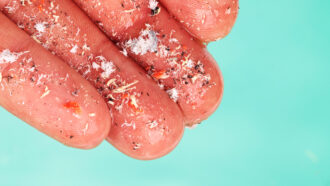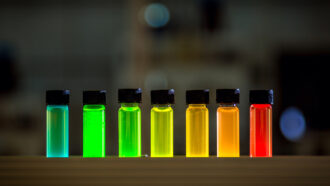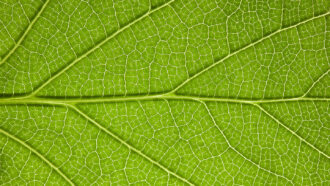Experiment: Kimchi chemistry
Let’s make kimchi from scratch and investigate changes in pH and glucose as it ferments

In this experiment, we learn about fermentation and pH by making a delicious Korean dish called kimchi.
ollo/E+/Getty Images
Listen to this story:
Have feedback on the audio version of this story? Let us know!
Objective: To investigate the chemical changes that occur in a batch of kimchi as it ferments
Areas of science: Cooking & Food Science
Difficulty: Hard intermediate
Time required: 1+ months
Prerequisites: None
Material availability: To obtain traditional Korean spices, you might have to go to an Asian market. But you can use commonly available substitutes, if desired.
Cost: Low ($20–$50)
Safety: No hazards
Credits: David B. Whyte, PhD, Science Buddies
Fermentation is used in the preparation of food for a variety of reasons, such as to produce complex flavors, to protect food from spoiling and to make dough rise. Fermentation refers to the biochemical changes brought about by the action of microorganisms. These can be bacterial or fungal organisms. Bacteria are key agents in the development of the characteristic smell and flavor of certain cheeses. And yeast, a single-celled fungus, is widely used in baking and in the production of ethanol-containing beverages.
The objective of this cooking and food science fair project is to investigate the chemical changes that occur in the process of making kimchi, a traditional Korean dish made from cabbage and a variety of other vegetables and spices. Kimchi is very popular in Korea. In fact, the Korea Aerospace Research Institute even developed “space kimchi” to accompany the first Korean astronaut to the Russian-manned space ship Soyuz.
The first step in making kimchi is typically to wet the cabbage and coat it with salt. The salt draws out the liquids in the cabbage cells, causing the cabbage to lose its firmness. The liquid is drawn from the cells by osmosis. Osmosis is defined as the diffusion of water molecules through a semipermeable membrane, from a place of higher concentration to a place of lower concentration. As the water moves out of the cells, the cell structure collapses, making the cabbage ready for the subsequent steps in the preparation of kimchi. This step in the process takes about six hours in this science fair project.
The salt is then washed off, and a mixture of vegetables, fresh salt, sugar and spices are added. The spices help give the final product its distinct flavor. The next step is where the real action takes place, chemically speaking. The mixture of cabbage and the other ingredients starts to change due to the activity of microorganisms. There are dozens, perhaps hundreds, of different kinds of microorganisms in the mix at this phase of the process, all carried in on the different ingredients.
One of the most important organisms for the unique flavors of kimchi is Lactobacillus plantarum, which has the common name lactic acid bacteria. You do not need to add Lactobacillus. There is enough of this organism on the cabbage to carry out the fermentation. Lactobacillus grows best in anaerobic conditions; that is, in low-oxygen conditions. Thus, the kimchi is fermented in a closed container to keep out air.
One process that occurs as a result of microbial activity is the breakdown of carbohydrates into simple sugars. These sugars, such as glucose, are then further metabolized to produce smaller products, including lactic acid. You will monitor the amount of glucose produced as the kimchi ferments, using glucose test strips that are available at most drug stores. The factors controlling the concentration of glucose are complex. Its concentration depends on both how fast it is being made by the breakdown of more complex sugars, and how fast it is being broken down into simpler molecules.
The biological processes carried out by Lactobacillus and other microorganisms in the kimchi result in the formation of lactic acid. As the amount of lactic acid increases, the pH of the kimchi decreases. In other words, the kimchi becomes acidic due to the increasing amounts of lactic acid. The pH scale measures how acidic or basic a solution is. Values for the pH of less than 7 indicate an acidic solution. Values for the pH that are greater than 7 indicate that the solution is basic. If the solution is neutral, then the pH is 7.0. You can monitor the synthesis of lactic acid by tracking the pH over time.
For more information, visit the Science Buddies page Acids, Bases & the pH Scale. As a variation on this science fair project, you can investigate how changing the amount of sugar affects lactic acid and glucose concentration. No matter how you do this science fair project, you will end up with a delicious and spicy batch of kimchi to enjoy!
Terms and concepts
- Fermentation
- Microorganism
- Bacteria
- Fungus
- Kimchi
- Cell
- Osmosis
- Diffusion
- Semi-permeable membrane
- Lactobacillus plantarum
- Lactic acid bacteria
- Anaerobic condition
- Metabolize
- Lactic acid
- Glucose test strips
- pH
- Acid
- Base
Questions
- What is the biochemical definition of fermentation?
- What is the chemical equation for the formation of lactic acid by anaerobic fermentation?
- What are some other food products that are made using fermentation?
- How does the fermentation in kimchi protect the final product from being spoiled by bacteria or fungus growth?
- What other common biochemical processes generate lactic acid in anaerobic conditions?
Materials and equipment
There are many recipes for kimchi, and any of them should work for this science fair project. The recipe below was modified from the recipe listed in the Bibliography.
Since this is a cooking and food science fair project, we will start with a list of ingredients.
- Napa cabbage (2 heads)
- Sea salt (1 cup)
- Fish sauce (1 Tbsp.)
- Green onions, chopped (5)
- Small white onion, minced (1/2 an onion)
- Garlic cloves, pressed (2)
- White sugar (sucrose) (2 Tbsp.)
- Ground ginger (1 tsp.)
- Korean chili powder (5 Tbsp.); to obtain traditional Korean spices, you might have to go to an Asian market; however, you can also substitute other types of chili powder, although this will alter the final flavor.
- Resealable bags, 1-gallon (2)
Next, here are some common items you will need.
- Bowl
- Spoon
- Measuring spoons
- Knife
- Permanent marker
- Cutting board
- Clock or stopwatch
- Colander
- Plastic containers with plastic lids, lids should fit snugly (4)
- Masking tape
- Gloves. These can be purchased at a local drug store or pharmacy, or through an online supplier like Carolina Biological Supply Company. If you are allergic to latex, use vinyl or polyethylene gloves.
- Thermometer. Available through online suppliers such as Carolina Biological Supply Company.
- Resealable plastic food storage bags, 1 gallon size
The items you will need to measure pH and glucose concentration are next.
- pH test strips; use both wide-range pH strips (pH 0 to 14) and narrow-range pH strips (pH 5.0 to 9.0), available from Carolina Biological Supply Company or other online suppliers.
- Note: The wide range is used to make sure that you can measure the whole range of pH values. The narrow range is used to give a more precise value for the pH.
- You could also use a pH pen in addition to the pH paper. A pH pen is an inexpensive (less than $60.00) pH meter. These are available online, from sites such as Carolina Biological Supply Company and Amazon.
- Glucose test strips; often glucose can be measured with regular urinalysis test strips that are available from Amazon.com. Glucose specific test strips can be bought online through suppliers such as Carolina Biological Supply Company.
- Lab notebook
- Graph paper
Experimental Procedure
Preparing the fermentation setup
Note: For this procedure, the kimchi will be split into four batches. You will track chemical changes in each batch. Feel free to modify the procedure if you wish, but make sure to keep good records.
- Cut the cabbages in half, lengthwise, and trim the ends.
- Rinse and cut the remaining cabbage into pieces, about 5-centimeter (2-inch) chunks.
- Place the cabbage into four large resealable bags. Using the permanent marker, label each bag with a number (1 to 4). Sprinkle salt on the leaves in the bags so they are evenly coated. Use your hands to rub the salt into the leaves.
- Seal the bags and leave them at room temperature for six hours.
- Record the time the experiment starts in your lab notebook.
- Using a colander, rinse the salt from the cabbage leaves, one bag at a time, and then drain and squeeze out any excess liquid.
- Place the cabbage from each bag in its own container with a tight-fitting lid. (You can also use a resealable plastic food storage bag, if you choose.) Label the containers with the corresponding sample number with the masking tape and permanent marker.
- Stir the fish sauce, green onions, white onion, garlic, sugar and ginger in a bowl.
- Split the mixture of fish sauce and other ingredients into four equal amounts.
- Add the fish sauce mixture to each of the four batches of cabbage.
- Sprinkle Korean chili powder over the mixtures. Use the same amount for each batch. Wear disposable gloves to protect your hands from the hot powder.
- Rub the chili powder into the cabbage leaves until they are all evenly coated. Note: Make sure not to touch your eyes or face with the chili powder.
Checking pH and glucose levels
- Read the pH paper — both the wide-range and the narrow-range paper — and glucose strip instructions and make sure you know how to use them.
- Using the wide-range pH paper, check the starting pH of each bag of kimchi. Record the data in your lab notebook. If the pH is between pH 5.0 to 9.0, use the narrow-range pH paper to get a more exact pH measurement. Record these data in your lab notebook, too.
- Check the starting glucose level of each bag of kimchi by dipping the glucose strip into the kimchi liquid and reading the glucose level using the color chart on the side of the canister. If the level of liquid is too low, add a small amount of water, mix it in and then measure the pH and glucose levels. Record all data in your lab notebook.
- Seal the container and set in a cool, dry place at room temperature between all readings.
- Allow the kimchi to ferment for three days at room temperature, checking the levels and making observations in your lab notebook, as follows in steps 6 to 11. The microorganisms will be very busy transforming your starting ingredients into kimchi. Store in a cool dry area, away from direct sunlight.
- Check the pH at least three times per day during the three days.
- Keep the top off for as little time as possible to keep oxygen out.
- Check first with the wide-range pH paper. If the pH is between pH 5.0 and 9.0, use the narrow-range pH paper to get a more exact measurement.
- Record the date, time and measurements in your lab notebook.
- Check the glucose level at least three times per day during the three days.
- Dip the glucose strip into the kimchi liquid and read the glucose level, using the color chart on the side of the canister.
- Keep the top off for as little time as possible to keep oxygen out.
- Record the date, time and measurements in your lab notebook.
- Dip the glucose strip into the kimchi liquid and read the glucose level, using the color chart on the side of the canister.
- Taste the kimchi at least once per day, during the three days, to see how the flavor is developing over time.
- Use your own words to describe how the flavor develops.
- Don’t adjust the ingredients to change the flavor. If you want to make a batch that is spicier, for example, start a whole new batch to split into four new bags.
- Record the temperature of the room each time you check the pH and glucose levels.
- You will not graph this, but it may be a factor if you wish to repeat your kimchi recipe.
- Now place the kimchi in the refrigerator for three weeks.
- Continue checking the pH and glucose levels on a once-per-day basis for the refrigerated kimchi over the three weeks.
- You can continue taking readings past the three-week mark if you choose.
Graphing your results
- Graph the pH change over time. Put the pH on the y-axis and the time on the x-axis.
- Graph the glucose concentration over time. Put the glucose concentration on the y-axis and the time on the x-axis.
- Graph the data for each batch separately.
- Also graph the average values for the pH and the glucose concentration.
- You could add notes to your graph that show how the flavor changed over time.
- “Flavor” and “spiciness” are not scientific terms, but they are important to note since the goal is to make a dish you will enjoy eating.
Variations
- Try different starting amounts of sugar. How does this affect the changes that occur in pH and glucose?
- Instead of fermenting the kimchi at room temperature for the first three days, ferment it in the refrigerator. How does this affect its fermentation?
- Vary the ingredients, using a different kimchi recipe. Do you get the same results?
- How does aeration affect the change in pH and glucose levels? Keep the top ajar for the first three days. Mix the kimchi up with a spoon several times per day to aerate it.
- What happens if you briefly heat the ingredients prior to starting fermentation? For example, to 60° Celsius (140° Fahrenheit) for 5 minutes.
This activity is brought to you in partnership with Science Buddies. Find the original activity on the Science Buddies website.








